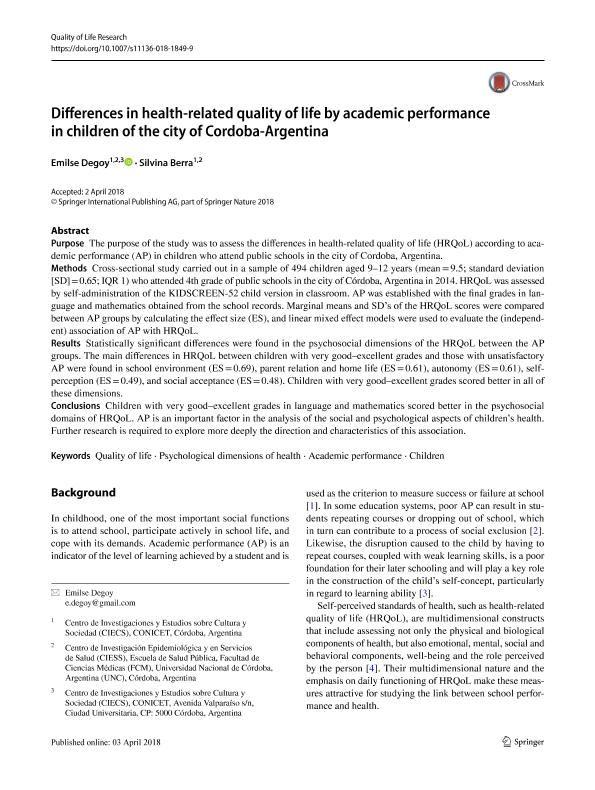Mostrar el registro sencillo del ítem
dc.contributor.author
Degoy, Emilse

dc.contributor.author
Berra, Silvina del Valle

dc.date.available
2019-12-10T16:44:01Z
dc.date.issued
2018-04
dc.identifier.citation
Degoy, Emilse; Berra, Silvina del Valle; Differences in health-related quality of life by academic performance in children of the city of Cordoba-Argentina; Springer; Quality Of Life Research : An International Journal Of Quality Of Life Aspects Of Treatment, Care And Rehabilitation.; 27; 6; 4-2018; 1463-1471
dc.identifier.issn
0962-9343
dc.identifier.uri
http://hdl.handle.net/11336/91891
dc.description.abstract
The purpose of the study was to assess the differences in health-related quality of life (HRQoL) according to academic performance (AP) in children who attend public schools in the city of Cordoba, Argentina. Methods Cross-sectional study carried out in a sample of 494 children aged 9–12 years (mean =9.5; standard deviation [SD]=0.65; IQR 1) who attended 4th grade of public schools in the city of Córdoba, Argentina in 2014. HRQoL was assessed by self-administration of the KIDSCREEN-52 child version in classroom. AP was established with the final grades in language and mathematics obtained from the school records. Marginal means and SD’s of the HRQoL scores were compared between AP groups by calculating the effect size (ES), and linear mixed effect models were used to evaluate the (independent) association of AP with HRQoL. Results Statistically significant differences were found in the psychosocial dimensions of the HRQoL between the AP groups. The main differences in HRQoL between children with very good–excellent grades and those with unsatisfactory AP were found in school environment (ES=0.69), parent relation and home life (ES=0.61), autonomy (ES=0.61), selfperception (ES=0.49), and social acceptance (ES=0.48). Children with very good–excellent grades scored better in all of these dimensions. Conclusions Children with very good–excellent grades in language and mathematics scored better in the psychosocial domains of HRQoL. AP is an important factor in the analysis of the social and psychological aspects of children’s health. Further research is required to explore more deeply the direction and characteristics of this association.
dc.format
application/pdf
dc.language.iso
eng
dc.publisher
Springer

dc.rights
info:eu-repo/semantics/openAccess
dc.rights.uri
https://creativecommons.org/licenses/by-nc-sa/2.5/ar/
dc.subject
Quality of life
dc.subject
Psychological dimensions of health
dc.subject
Academic performance
dc.subject
Children
dc.subject.classification
Otras Ciencias de la Salud

dc.subject.classification
Ciencias de la Salud

dc.subject.classification
CIENCIAS MÉDICAS Y DE LA SALUD

dc.title
Differences in health-related quality of life by academic performance in children of the city of Cordoba-Argentina
dc.type
info:eu-repo/semantics/article
dc.type
info:ar-repo/semantics/artículo
dc.type
info:eu-repo/semantics/publishedVersion
dc.date.updated
2019-10-24T18:19:24Z
dc.identifier.eissn
1573-2649
dc.journal.volume
27
dc.journal.number
6
dc.journal.pagination
1463-1471
dc.journal.pais
Alemania

dc.journal.ciudad
Berlin
dc.description.fil
Fil: Degoy, Emilse. Consejo Nacional de Investigaciones Científicas y Técnicas. Centro Científico Tecnológico Conicet - Córdoba. Centro de Investigaciones y Estudios sobre Cultura y Sociedad. Universidad Nacional de Córdoba. Centro de Investigaciones y Estudios sobre Cultura y Sociedad; Argentina
dc.description.fil
Fil: Berra, Silvina del Valle. Consejo Nacional de Investigaciones Científicas y Técnicas. Centro Científico Tecnológico Conicet - Córdoba. Centro de Investigaciones y Estudios sobre Cultura y Sociedad. Universidad Nacional de Córdoba. Centro de Investigaciones y Estudios sobre Cultura y Sociedad; Argentina
dc.journal.title
Quality Of Life Research : An International Journal Of Quality Of Life Aspects Of Treatment, Care And Rehabilitation.

dc.relation.alternativeid
info:eu-repo/semantics/altIdentifier/url/http://link.springer.com/10.1007/s11136-018-1849-9
dc.relation.alternativeid
info:eu-repo/semantics/altIdentifier/doi/http://dx.doi.org/10.1007%2Fs11136-018-1849-9
dc.relation.alternativeid
info:eu-repo/semantics/altIdentifier/url/https://www.ncbi.nlm.nih.gov/pubmed/29616428
Archivos asociados
